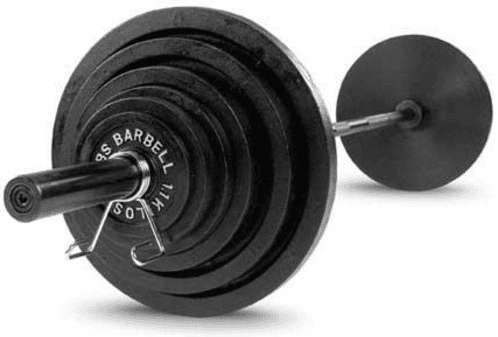When my friend Sol from Examine.com told me that he and his colleague Skip were working on a post examining the science behind some of the anti-running claims making the rounds of the blogosphere lately, I was excited to feature it here on my blog. I have a lot of friends and readers who will be very interested in their interpretation. Be sure to check out their website too, they offer some of the most sound, evidence based health and fitness information I’ve found on the internet. Enjoy! ~Go Kaleo
Why Women Should Not Run. Run and You’ll Only Die Tired. One Running Shoe in the Grave. Just a sampling of the anti-cardio articles we’ve seen in the past year.
Low-intensity steady-state (LISS) cardio has gotten a bad rap. Somewhere along the line, being fit and healthy got redefined to exclude endurance work. Long and steady cardio is now the height of boredom, a waste of time, and ' worse yet ' the antithesis of “gains.” No longer do we need to log endless miles to burn off stubborn fat (regardless of whether you enjoy cardio or not).
Hyperbolic? Not if you’ve read the plethora of anti-cardio articles these days.
Recently, an article titled Why Women Should Not Run, by John Kiefer, has been making the rounds. The article casts a damning light on steady state-cardio, seemingly with plenty of science to back it up. People see the high citation count, and immediately think that the assertions made must be true. Unfortunately, the citations it contains rarely relate to the statements that are made. Taking very specific studies and converting them into heavily generalized statements, the article is a testament to the lazy and sensationalistic “science-based fitness” that is currently running amok on the Internet.
“Why Women Should Not Run”
Before we get into claims and citations, there’s an underlying source of confusion throughout this article. The title is generalized to all women, and the author sets up a familiar example that could be applicable to many women: his friend “Jessica.” Jessica’s story is certainly one many women can relate to, or is at least something nearly everyone has seen or can envision.
However, as the article progresses we begin moving further and further away from this situation. The author mentions physique competitors and their coaches and portrays them as the source of his ire. As we move to the end of the piece, it focuses on binging, post-contest figure athletes. While this situation will be relevant to a few women, we’ve certainly moved a long way from the generality set up by the title and opening anecdote.
Speaking of binging, this brings up another area where this article is lacking ' dietary control. The author goes to great lengths to set up cardio as a metabolism-halting, fat-gaining nightmare, yet never mentions the effect (or lack thereof) of one’s diet on this process. This highlights the possibility the author may be overstating the relative influence of LISS on the issue. If that’s the case, it’s ironic given the author’s previous writing against “exercise-only” weight-loss plans. To quote from the piece: “Succinctly: Exercise alone does not cause significant weight loss.”
Finally, the last general weakness comes from how the author quantifies the problem. Words like “over-prescribed,” “too much,” and “excessive” appear throughout this article to describe the amount of cardio these women are doing. It should go without saying, but “too much” is never a good amount of anything. In fact, it’s inherently a bad amount ' too much water can kill you! What amount of cardio does the author use to highlight how much is actually too much? One to three months of 20+ hours per week. That’s three hours a day, every day. Done at a reasonable pace of 12 min/mile this equates to at least 100 miles/week. Unfortunately, the author provides no basis for the establishment of this threshold. No doubt there are women out there that log that much time, but how well does this relate back to our prototypical “Jessica?”
How many women do you know who log an average of 3 hours of cardio every day? If you do know one, is she fat?
Somehow, the anecdotal woman is a figure competitor and does 3+ hours of cardio every day.
“Science Wants You to Stop Running”
A main premise of this article is that too much cardio slows the body’s metabolism, especially in women. The author supports this claim with his first collection of citations:
the most detrimental effect of [steady-state] training'one that applies specifically to women: Studies'both clinical and observational'make a compelling case that too much cardio can impair the production of the thyroid hormone T3, its effectiveness and metabolism[1-11], particularly when accompanied by caloric restriction, an all too common practice.
In the first incarnation of this article the author took a much more hard-nosed approach on this idea, but softened the language due to initial critiques. Unfortunately, the current language is still misleading. We’re about to get science-heavy as we investigate these citations.
Five of the eleven citations used here to support steady-state training’s detrimental effects specifically in women relied solely on male subjects [4, 5, 8, 9, 10], and two of those used rats [8, 9]. A sixth looked at mixed subjects [3], though still weighted heavily toward males. When making claims about a specific population, we want studies that use subjects that match the target group as closely as possible. When sex differences exist, we cannot use male subjects to validate processes and outcomes occurring in women. If we ignore this error though and take the group of citations as a whole, it still portrays a very different picture than the one the author is attempting to paint.
The author’s citations highlight that there are responders and non-responders to exercise-induced declines in T3 levels (10 responders to 7 non-responders) [1]. So this problem of reduced T3 does not necessarily manifest in all women all the time. After the initial decline at the start of training seasons, T3 levels started to trend back towards baseline [1, 2]. Others report no change in T3 levels at all [3, 5], in direct contradiction to the author’s claim.
The citations state that T3 may initially decline, but it returns back to baseline. It is an adaptive response, not a permanent one.
The studies most relevant to this issue [6, 7] showed that it was not cardio alone ' either low or high intensities ' that impacted T3 levels, but rather an issue of energy availability. To quote the researchers:
“Neither the volume nor the intensity of exercise had any effect on T3 levels beyond the impact of the energy cost of exercise on energy availability.” [6]
And again:
“the results of this experiment suggest that exercising women may be able to prevent or to reverse [thyroid-related] reproductive disorders through dietary reform without reducing either the volume or the intensity of their exercise regimen.” [6]
In a follow-up study [7], the same authors determined a threshold level of energy availability below which T3 levels start to be affected, namely within the range of 19-25 calories per kilogram of lean body mass per day. The authors even propose a scenario where a woman similar to their subjects could inadvertently create such a situation: by reducing her energy intake by 450 calories per day while performing aerobic exercise equivalent to running 5 miles a day. Not an extreme situation.
The studies themselves found that that it was energy availability, not cardio per se, that impacted T3 levels.
However, what none of these sources show is steady-state cardio having a detrimental effect to weight-loss efforts, even in the presence of decreased T3 levels. To quote the authors of the first citation:
“Between the (') responder and non-responder rowers, there were no significant differences in physical characteristics, training history, performance times, or hydration status' Furthermore, the changes observed in the (') responder rowers for fT3, TSH and leptin were not significantly correlated with changes in body mass, percentage body fat or hydration status over the course of the study.” [1]
The author seems to think this is irrelevant, as he continues to paint a bleak picture by blasting out another twenty citations on T3, from its cellular effects to its role in fat loss. Yet these citations only illustrate the mechanics and influence of T3. They say nothing of its real-world effects on weight loss when steady-state cardio and caloric deficits are paired.
To be fair, there is clearly something going on with T3 here, and it does act in various roles throughout the body. But nothing the author has cited has identified anything to support the idea that cardio sabotages weight loss by decreasing T3 levels, even in the face of a caloric deficit.
The citations used not only showed no long-term decrease in T3 due to exercise, they also showed no negative impact on weight even if T3 was decreased.
“We Were Not Designed For This”
In the next section, the author continues with the supposed ill effects of steady-state cardio. Leaving T3 behind, we are now told that traditional cardio work alters the way your body burns fat; where muscles’ ability to burn fat is compromised, and the body takes extraordinary measures to preserve fat stores.
Training consistently at 65 percent or more of your max heart rate adapts your body to save as much body fat as possible. After regular training, fat cells stop releasing fat the way they once did during moderate-intensity activities[32-33]. Energy from body fat stores also decreases by 30 percent[34-35].
Papers 32-34 are all investigating the acute changes in the mechanics of fuel substrate utilization during exercise at differing levels of VO2max.
If you are not familiar with this idea, as the intensity of exercise increases the body tends to rely less on fat as the primary fuel source, and more on carbohydrate sources. The cited papers are investigating how this acute shift occurs and what factors mediate it. This is a normal physiological process.
Citation 35 shows the changes in substrate use after 12 weeks of endurance training. That study did indeed find that after twelve weeks of training, body fat stores were relied upon less to provide fuel for exercise ' 30% less as correctly noted in the author’s article. However, this decrease is taken completely out of context.
Before the 12 weeks of training, the subjects did a pre-test. What the scientists found was that the test exercise (90-120 minutes of cycling at 63% VO2max) utilized carbohydrate sources to fuel 60% of the effort. The remaining 40% came from body fat stores (17%) and from fatty acids stored within the exercised muscles (23%). After the twelve weeks of training, the same test was retaken, and the researchers found that carbohydrate usage declined to 40% of fuel needs and body fat stores down to 13%. To make up the difference, intramuscular fatty acids provided nearly half of the energy requirements at 47%. The study basically found that carbohydrate usage dropped 33%, body fat storage usage dropped 28%, but intramuscular fatty acid usage went up 113%! This effect appears to be a normal adaptation to endurance training (1, 2, 3).
However, all the above effects are observed during exercise. Shifts in substrate utilization during an exercise bout are not as important relative to one’s caloric deficit for long-term weight loss goals (4, 5, 6). Endurance exercise does not induce fat loss on its own. It is used to create or augment a caloric deficit which then creates the desired fat loss.
Endurance training appears to increase the amount of total fatty acids burned during a moderate intensity bout of exercise.
To this end, your body sets into motion a series of reactions that make it difficult for muscle to burn fat at all[36-41]. Instead of burning body fat, your body takes extraordinary measures to retain it.
The first sentence is in direct contradiction to the previous sources given. Citation 35 found a 100% increase in fat use in muscles. Here again, papers 36-41 are investigating the pathways involved in fat metabolism and its use a fuel substrate. None of these sources show a link between endurance training and the muscles’ ability to burn fat beyond the normal transition to rely more heavily on carbohydrate oxidation as exercise intensity increases. The bold claim that the body takes “extraordinary measures” to retain body fat goes uncited.
The primary citation for cardio making it “difficult for muscle to burn fat” actually showed a 100% increase in fat usage in muscles.
The most critical statement, “instead of burning body fat, your body takes extraordinary measures to retain it” goes unsupported.
That’s not all. You can still lose muscle mass. Too much steady-state cardio actually triggers the loss of muscle[42-45].
The competing effects of muscular hypertrophy and endurance training are well researched. Simply put, you can’t be a top-tier bodybuilder and a top-tier endurance athlete. Just looking at real-world athletes will highlight this fact without the need to get into the underlying molecular processes, to say nothing of the time requirements. However, the choice of citations here is odd.
Paper 42 is a case study on a woman who ran 4500 miles across Canada over the course of 112 days (equivalent to 1.5 marathons a day). She did indeed lose lean body mass (LBM ' which includes more than just muscle mass), nearly 7 lbs worth. She also lost just less than 30 lbs of fat. Averaging 8 hours of running a day, for almost three months, on a 1000 calorie/day deficit, this woman is doing everything the author is ranting against. Yet, amazingly she managed to lose a considerable amount of fat even though she must surely be below the T3 threshold established earlier. It’s unfortunate her thyroid levels were not also monitored.
In paper 43, the freshman rowers did lose 2 lb of LBM over the course of six months with ad libitum food intake. However, the World Championship Rowers studied alongside them showed no changes in LBM.
The subjects in paper 44 increased muscle mass after the 5-week training protocol.
Paper 45 did not include exercise, steady state or otherwise. It did, however, find decreased T3 and increased urinary nitrogen excretion in subjects that consumed a diet that only had 2% carbohydrate content for eleven days. Subjects consuming diets with 85% and 44% did not experience these changes. How that is relevant is unknown.
The claim made was “steady-state cardio yields a loss in LBM,” yet these papers either directly contradict the author’s main premise or challenge the inevitability of muscle loss from cardio.
What follows is another dump of citations blaming increased cortisol for muscle loss, name-dropping myostatin, and then leaping to decreased bone density because of all this muscle mass runners are supposedly losing. If that’s not a slippery slope, it certainly sets one up:
And long term health? Out the window, as well. Your percentage of muscle mass is an independent indicator of health[65]. You’ll lose muscle, lose bone, and lose health. Awesome, right?
Let this one sink in a bit. According to the author, running is detrimental to your long-term health because of all the running-induced muscle loss (even though his previous citations contradicted that claim). Forget about all the known benefits of endurance training; it seems the only thing that matters is muscle. The possibility that endurance running can help in other facets of health are not even considered. Without a doubt, lean tissue can be an indicator of overall health status, but health is not necessarily solely dependent on lean tissue. Furthermore, the author makes no distinction between the lean tissue and strength levels of endurance-trained individuals to their sedentary counterparts, the latter being the population these sort of epidemiological studies are based upon.
When sewn together, these phenomena coordinate a symphony of fat gain for most female competitors after figure contests. After a month'or three'of 20-plus hours of cardio per week, fat burning hits astonishing lows, and fat cells await an onslaught of calories to store[66-72].
There is no need to invoke aggrandized ideas about the detriments of steady-state cardio to explain the propensity of female figure competitors to gain fat after a contest. These women have spent the previous weeks and months training intensely and dieting down to unsustainable levels of body fat. Post-contest is typically a recovery period where training is dialed back, and dietary controls are slackened. Moving less and eating more isn’t exactly a novel scenario when it comes to fat gain.
Figure competitors diet down to unsustainably low body fat levels for competitive edge, not health. Rebounding to higher levels is healthy and even necessary. Previous running sessions are not to blame.
The worst thing imaginable in this state would be to eat whatever you wanted, whenever you wanted. The combination of elevated insulin and cortisol would make you fat, and it would also create new fat cells so you could become even fatter[73-80.]
So this state (extremely lean, extremely stressed) is not a good place to be in to start binging. How does this relate to Jessica or “why women should not run?” This section seems to summarize more as “don’t overtrain and overeat.”
When diet is finally discussed, the examples given could only be classified as binging. The dietary protocol accompanying the observed rapid fat gain is described as 4000 calories of “gluttony,” “feeding frenzy,” and “devastation” ' yet the author is still pointing the finger at excessive cardio.
“Science” by Citations
For some reason, many fitness writers tend to see the world in a binary of only black or white. There is no gray, there is no compromise. This bull-headed approach to fitness advice is overly restrictive and misleading. Absolutes are rarely valid in this field.
Thyroid hormones can vary significantly between people and even within an individual (7, 8). Even if depressed levels are found, the condition could present no symptoms and there is no agreement on appropriate methods of treatment (9, 10). The author’s own citations show we cannot lay the blame for declining levels (if and when they occur) on steady-state cardio alone, and even then, declining levels do not necessarily halt or reverse fat loss efforts. And it’s not only low-to-moderate intensity steady-steady cardio that affects your thyroid. High-intensity intervals have been shown to acutely decrease thyroid levels more than steady-state cardio (11, 12) and weight training isn’t completely off the hook either (13, 14).
Yes, running has been shown to decrease total lean body mass, but it’s also been shown to simultaneously increase lean mass in the limbs (15), and has been shown to have no effect (16) or even a protective effect (17) on age-related muscle loss. And while running may lose out to weight training for increasing bone density, it has been shown to improve it nonetheless (18, 19, 20, 21) and to outperform cycling and swimming (22, 23).
Meanwhile, improvements in health parameters (reduced blood pressure [24], increased insulin sensitivity [25], reduced liver fat [26], improved vasodilation [27], telomere protection [28], etc.) abound from regular endurance work that actually tend to result in reduced mortality rates (29, 30, 31).
That being said, there is some emerging evidence that you can do too much endurance training. Going overboard with steady-state cardio can lead one to the point of diminishing returns or even outright health detriments (32, 33, 34). People that generally engage in this level of endurance work, however, are rarely in it for the health aspect. Typically, sports performance is their ultimate goal, and often increasing one’s performance or ability in any sport comes at a detriment to overall health. This is the same situation figure competitors fall under.
Unfortunately, “too much” steady-state work has yet to be quantified, but it is safe to say that it is significantly higher than zero. For general health and fitness, moderate amounts of steady-state training can have a place in any comprehensive workout or training routine. It can complement and potentially enhance other aspects of one’s training (15, 35, 36, 37). That said, endurance training may detract from sport-specific goals, so each person needs to program their training accordingly. Despite many fitness writers’ claims to the contrary, there is no one-size-fits-all program that is optimal for everyone and their myriad goals or preferences.
And don’t forget that your dietary approach is integral to the success of your training. If fat loss if your goal but your diet is not in sync with that outcome, you will inevitably fail. The author used to espouse this himself, but seems to have forgotten it during the writing of his anti-cardio rant.
There is ample evidence that steady-state cardio has a plethora of health benefits. We’ve provided relevant citations above.
So is running bad for women?
In the end, the anecdotes and 79 citations in this article (one was listed twice) are a smoke screen to hide the precarious claim the author makes: that cardio above a walk or below a sprint is bad for you (especially if you are a woman). That women are destroying their metabolisms, losing muscle and bone mass, holding onto ' if not adding ' fat, and dying earlier from decreased health. Yet the evidence presented was poor and does not support the claims made. Fear-based marketing may get page views and sell your ebook, but the amount of sensationalism used was appalling. We would not expect to apply the physical/dietary habits of NFL players to the general male population, so why is it acceptable to do so for women and professional figure athletes?
It’s damning enough that the citations, when not outright contradicting the assertions made, seem to be cherry-picked papers and spurious links between mechanisms with all the blame being laid on cardio. Beyond that, the extreme example of 20+ hours
of cardio per week combined with binge eating is given to characterize the problem plaguing “Jessicas” in gyms across the nation, as if these two approaches are one and the same.
If anything should be taken away from John Kiefer’s article, it has little to do with running. What should be learned from this article is that a string of numbers after a claim does not automatically make it true. As a reader you should always check up on an author’s sources and come to your own conclusions after you’ve judged the evidence for yourself. If you were looking for an echo chamber to confirm your anti-endurance opinions, then the article was exactly what you wanted. But why mislead readers with contradicting or tangential citations? Why talk in certainties when none exist? Why use small, unrepresentative populations to generalize to the average woman?
Only the author can answer these questions.
Steady-state cardio has been shown numerous times to have many health benefits leading to decreased mortality risks. Sure, “too much” (so far quantified only as “long term and excessive” amounts typically used by competitive, extreme distance athletes) is not good for you and can be detrimental to general health and fitness goals. But for all the Jessicas out there, moderate amounts can easily be included in a well-rounded routine to complement fat loss goals or general health pursuits.
That said, steady-state cardio is not a requirement. If someone doesn’t want to do it or doesn’t like it, there are other alternatives that can be used. What this all boils down to is this: If you enjoy running and feel it benefits you and your training, and aligns with your goals' then keep on running.
When reading the actual scientific papers referenced by John Kiefer, there was actually no evidence that the cardio that the average “Jessica” partakes in has any detrimental effects; if anything, there is a vast amount of scientific evidence that it is helpful.
Skip Bouma and Sol Orwell contribute to Examine.com, where they help make sense of scientific research across health and fitness.





